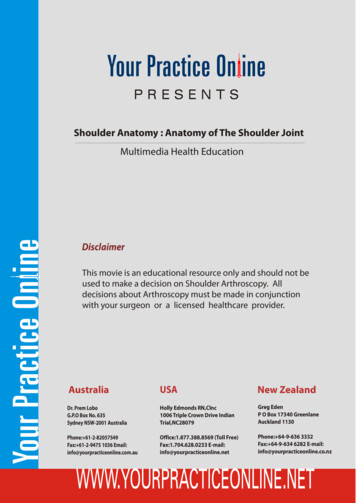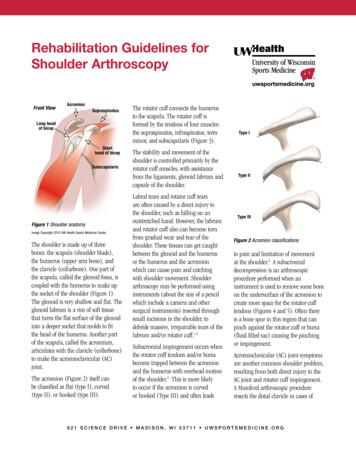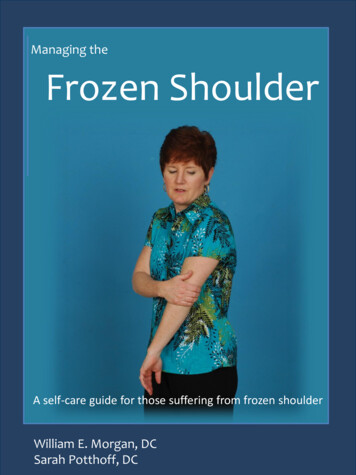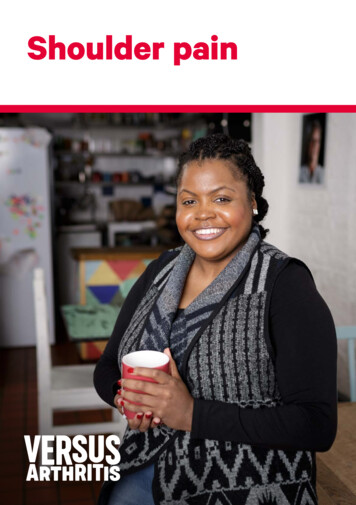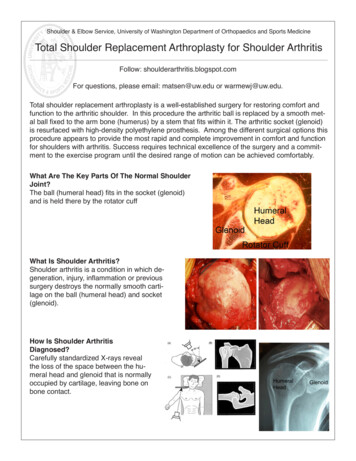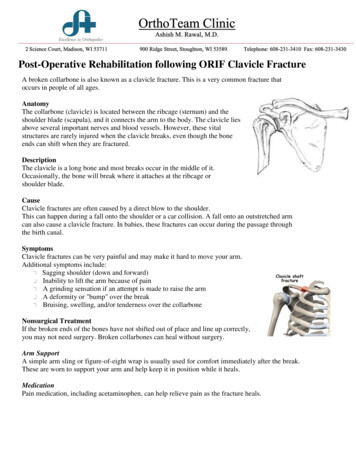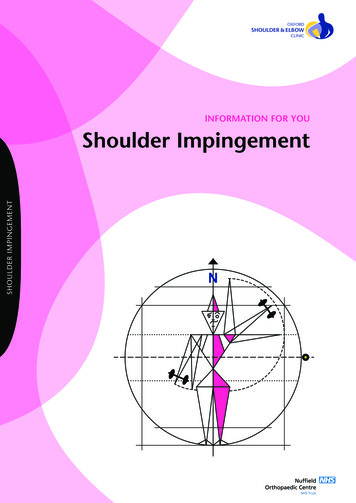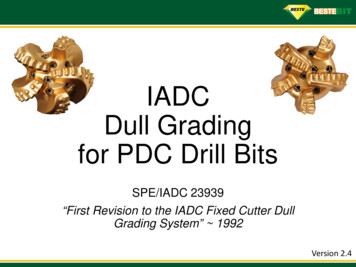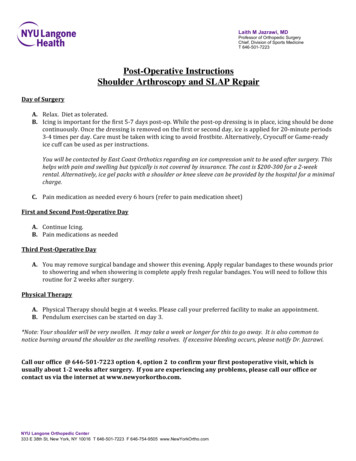
Transcription
Laith M Jazrawi, MDProfessor of Orthopedic SurgeryChief, Division of Sports MedicineT 646-501-7223Post-Operative InstructionsShoulder Arthroscopy and SLAP RepairDay of SurgeryA. Relax. Diet as tolerated.B. Icing is important for the first 5-7 days post-op. While the post-op dressing is in place, icing should be donecontinuously. Once the dressing is removed on the first or second day, ice is applied for 20-minute periods3-4 times per day. Care must be taken with icing to avoid frostbite. Alternatively, Cryocuff or Game-readyice cuff can be used as per instructions.You will be contacted by East Coast Orthotics regarding an ice compression unit to be used after surgery. Thishelps with pain and swelling but typically is not covered by insurance. The cost is 200-300 for a 2-weekrental. Alternatively, ice gel packs with a shoulder or knee sleeve can be provided by the hospital for a minimalcharge.C. Pain medication as needed every 6 hours (refer to pain medication sheet)First and Second Post-Operative DayA. Continue Icing.B. Pain medications as neededThird Post-Operative DayA. You may remove surgical bandage and shower this evening. Apply regular bandages to these wounds priorto showering and when showering is complete apply fresh regular bandages. You will need to follow thisroutine for 2 weeks after surgery.Physical TherapyA. Physical Therapy should begin at 4 weeks. Please call your preferred facility to make an appointment.B. Pendulum exercises can be started on day 3.*Note: Your shoulder will be very swollen. It may take a week or longer for this to go away. It is also common tonotice burning around the shoulder as the swelling resolves. If excessive bleeding occurs, please notify Dr. Jazrawi.Call our office @ 646-501-7223 option 4, option 2 to confirm your first postoperative visit, which isusually about 1-2 weeks after surgery. If you are experiencing any problems, please call our office orcontact us via the internet at www.newyorkortho.com.NYU Langone Orthopedic Center333 E 38th St, New York, NY 10016 T 646-501-7223 F 646-754-9505 www.NewYorkOrtho.com
Dr. Laith M. JazrawiChief, Division of Sports MedicineAssociate Professor Department of Orthopaedic SurgeryRehabilitation After Arthroscopic SLAP RepairThe anatomic configuration of the shoulder joint (glenohumeral joint) is oftencompared to a golf ball on a tee. This is because the articular surface of the roundhumeral head is approximately four times greater than that of the relatively at shoulderblade face (glenoid fossa)1 (Figure 1). The stability and movement of the shoulder iscontrolled by the rotator cuff muscles, as well as the shoulder ligaments, the capsule ofthe shoulder and the glenoid labrum. The labrum is a fibrocartilagenous ring whichattaches to the bony rim of the glenoid fossa.1 The labrum doubles the depth of theglenoid fossa to help provide stability.2 An analogy would be a parked car on a hillsidewith a block under the tire — the round tire being the humeral head, the road being theglenoid fossa and the block being the labrum. The labrum also serves as the anchor forthe long head of the biceps. A large portion of the long head of the biceps originatesfrom the top (superior) portion of the labrum. Overhead sports can create significantforces at this attachment site. This can ultimately lead to injury and tears of the bicepsoff this attachment. This is called a SLAP lesion (Superior Labral Anterior to Posteriortear). These injuries can also occur from trauma, such as falling on your arm, bracingyour arm in an accident, arm tackling in football or any large sudden force applied tothe arm. There are four basic types of SLAP tears.3 A Type II SLAP tear is the mostcommon type of SLAP tear requiring surgical reconstruction (Figure 2).3 In this type oftear the long head of the biceps remains attached to the labrum but the labrum hasbeen detached from the333 38th St. New York, NY 10016 (646) 501 7047 newyorkortho.com
Rehabilitation After Arthroscopic SLAP Repairbony glenoid.4 This is repairedsurgically by placing sutureanchors (Figure 3) in the glenoidfossa, passing sutures throughthe labrum and then tyingspecial surgical knots toapproximate the labrum back tothe bony glenoid rim.Full return to throwing andcontact sports occurs in 80-90%of athletes.4, 5 Successful returnto sport and activity isdependent on following postoperative precautions andcompleting a structured postoperative rehabilitation program.Our rehabilitation program isoutlined below. Therehabilitation guidelines arepresented in a criterion basedprogression. General timeframes are given for reference tothe average, but individualpatients will progress at differentrates depending on their age,associated injuries, pre-injuryhealth status, rehabilitationcompliance and injury severity.These factors will also affecthow long it takes each individualto meet the required criteria forreturn to sport and activity.4333 38th St. New York, NY 10016 (646) 501 7047 newyorkortho.com
Rehabilitation After Arthroscopic SLAP RepairPhase I (Surgery to 4 weeks after surgery)GoalsooProtection of shoulder after surgeryActivate muscles that help stabilize your glenohumeral and scapulo-thoracicjointsPrecautionsoSling immobilization at all times except for showering and rehabilitationunder guidance of physical therapistRange of MotionExercisesooActive assistive range of motion (AAROM) active range of motion (AROM)Restrict motion to 140 of Forward Flexion, 40 of External Rotation andInternal Rotation to stomachNo Internal Rotation up the backNo External Rotation behind the headooTherapeuticExercisesooooWrist/Hand Range of MotionGrip StrengtheningIsometric Abduction, Internal/External Rotation exercises with elbow at sideNo resisted Forward Flexion/Elbow Flexion (to avoid stressing the bicepsorigin)Other SuggestionsoHeat/Ice before and after PT sessionsPhase II (4 weeks to 6 weeks following surgery)GoalsooIncreased AROMIncreased rotator cuff strength in a neutral positionPrecautionsoDiscontinue sling immobilizationRange of MotionExercisesoIncrease Forward Flexion, Internal/External Rotation to full motion astoleratedTherapeuticExercisesooAdvance isometrics from Phase I to use of a theraband within AROMlimitationsContinue with Wrist/Hand Range of Motion and Grip StrengtheningBegin Prone Extensions and Scapular Stabilizing Exercises(traps/rhomboids/levator scapula)Gentle joint mobilizationoModalities per PT discretionOther Suggestionsoo333 38th St. New York, NY 10016 (646) 501 7047 newyorkortho.com
Rehabilitation After Arthroscopic SLAP RepairPhase III (6 weeks to 12 weeks following surgery)GoalsoProgress to full AROM without discomfortRange of MotionExercisesooooActive assistive range of motion (AAROM) active range of motion (AROM)Restrict motion to 140 of Forward Flexion, 40 of External Rotation andInternal Rotation to stomachNo Internal Rotation up the backNo External Rotation behind the headTherapeuticExercisesooooAdvance Theraband exercises to light weights (1-5 lbs)8-12 repetitions/2-3 sets for Rotator Cuff, Deltoid and Scapular StabilizersContinue and progress with Phase II exercisesBegin UE ergometerOther SuggestionsoModalities per PT discretionPhase IV (3 months to 6 months following surgery)GoalsoFull range of motion without discomfortTherapeuticExercisesoooooAdvance exercises in Phase III (strengthening 3x per week)Sport/Work specific rehabilitationReturn to throwing at 4.5 monthsReturn to sports at 6 months if approvedOther SuggestionsModalities per PT discretionReferences333 38th St. New York, NY 10016 (646) 501 7047 newyorkortho.com
Laith M Jazrawi, MDProfessor of Orthopedic SurgeryChief, Division of Sports MedicineT 646-501-7223Rehabilitation Protocol: Arthroscopic SLAP RepairName:Date:Diagnosis:Date of Surgery:Phase I (Weeks 0-4) Sling immobilization at all times except for showering and rehab under guidance of PT Range of Motion –AAROM à AROM as toleratedo Restrict motion to 140 of Forward Flexion, 40 of External Rotation and Internal Rotation to stomacho No Internal Rotation up the back/No External Rotation behind the head Therapeutic Exerciseo Wrist/Hand Range of Motiono Grip Strengtheningo Isometric Abduction, Internal/External Rotation exercises with elbow at sideo No resisted Forward Flexion/Elbow Flexion (to avoid stressing the biceps origin) Heat/Ice before and after PT sessionsPhase II (Weeks 4-6) Discontinue sling immobilization Range of Motion – Increase Forward Flexion, Internal/External Rotation to full motion as tolerated Therapeutic Exerciseo Advance isometrics from Phase I to use of a theraband within AROM limitationso Continue with Wrist/Hand Range of Motion and Grip Strengtheningo Begin Prone Extensions and Scapular Stabilizing Exercises (traps/rhomboids/levator scapula)o Gentle joint mobilization Modalities per PT discretionPhase III (Weeks 6-12) Range of Motion – Progress to full AROM without discomfort Therapeutic Exercise – Advance theraband exercises to light weights (1-5 lbs)o 8-12 repetitions/2-3 sets for Rotator Cuff, Deltoid and Scapular Stabilizerso Continue and progress with Phase II exerciseso Begin UE ergometer Modalities per PT discretionPhase IV (Months 3-6) Range of Motion – Full without discomfort Therapeutic Exercise – Advance exercises in Phase III (strengthening 3x per week)o Sport/Work specific rehabilitationo Return to throwing at 4.5 monthso Return to sports at 6 months if approved Modalities per PT discretionComments:Frequency: times per weekDuration: weeksSignature:NYU Langone Orthopedic Center333 E 38th St, New York, NY 10016 T 646-501-7223 F 646-754-9505 www.NewYorkOrtho.comDate:
NYU Langone Orthopedic Center 333 E 38th St, New York, NY 10016 T 646-501-7223 F 646-754-9505 www.NewYorkOrtho.com Post-Operative Instructions Shoulder Arthroscopy and SLAP Repair Day of Surgery A. Relax. Diet as tolerated. B. Icing is important for the first 5-7 days post-op. While the post-op dressing is in place, icing should be done

